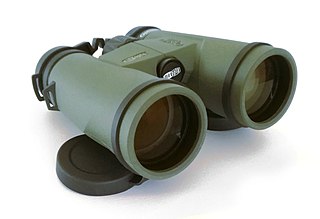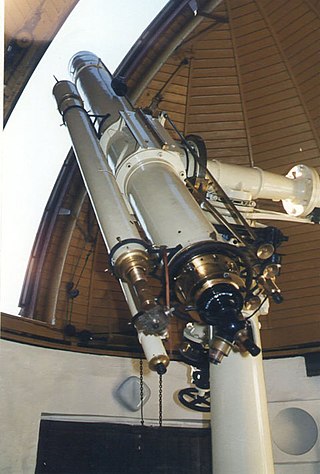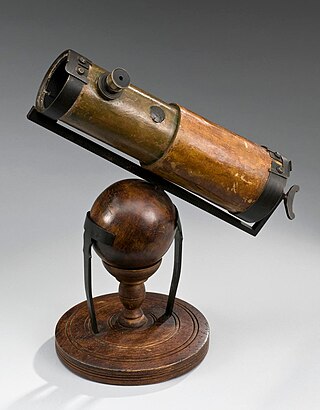Related Research Articles

A sniper is a military or paramilitary marksman who engages targets from positions of concealment or at distances exceeding the target's detection capabilities. Snipers generally have specialized training and are equipped with telescopic sights. Modern snipers use high-precision rifles and high-magnification optics. They often also serve as scouts/observers feeding tactical information back to their units or command headquarters.

Binoculars or field glasses are two refracting telescopes mounted side-by-side and aligned to point in the same direction, allowing the viewer to use both eyes when viewing distant objects. Most binoculars are sized to be held using both hands, although sizes vary widely from opera glasses to large pedestal-mounted military models.

A spotting scope is a compact lightweight portable telescope optimized for detailed observation of distant objects. They are used as tripod mounted optical enhancement devices for various outdoor activities such as birdwatching, skygazing and other naturalist activities, for hunting and target shooting to verify a marksman's shot placements, for tactical ranging and surveillance, and for any other application that requires higher magnification than ordinary binoculars.

A monocular is a compact refracting telescope used to magnify images of distant objects, typically using an optical prism to ensure an erect image, instead of using relay lenses like most telescopic sights. The volume and weight of a monocular are typically less than half of a pair of binoculars with similar optical properties, making it more portable and also less expensive. This is because binoculars are essentially a pair of monoculars packed together — one for each eye. As a result, monoculars only produce two-dimensional images, while binoculars can use two parallaxed images to produce binocular vision, which allows stereopsis and depth perception.

A refracting telescope is a type of optical telescope that uses a lens as its objective to form an image. The refracting telescope design was originally used in spyglasses and astronomical telescopes but is also used for long-focus camera lenses. Although large refracting telescopes were very popular in the second half of the 19th century, for most research purposes, the refracting telescope has been superseded by the reflecting telescope, which allows larger apertures. A refractor's magnification is calculated by dividing the focal length of the objective lens by that of the eyepiece.

An optical telescope is a telescope that gathers and focuses light mainly from the visible part of the electromagnetic spectrum, to create a magnified image for direct visual inspection, to make a photograph, or to collect data through electronic image sensors.

A reflecting telescope is a telescope that uses a single or a combination of curved mirrors that reflect light and form an image. The reflecting telescope was invented in the 17th century by Isaac Newton as an alternative to the refracting telescope which, at that time, was a design that suffered from severe chromatic aberration. Although reflecting telescopes produce other types of optical aberrations, it is a design that allows for very large diameter objectives. Almost all of the major telescopes used in astronomy research are reflectors. Many variant forms are in use and some employ extra optical elements to improve image quality or place the image in a mechanically advantageous position. Since reflecting telescopes use mirrors, the design is sometimes referred to as a catoptric telescope.
Carlos Norman Hathcock II was a United States Marine Corps (USMC) sniper with a service record of 93 confirmed kills. Hathcock's record and the extraordinary details of the missions he undertook made him a legend in the U.S. Marine Corps. He was honored by having a rifle named after him: a variant of the M21 dubbed the Springfield Armory M25 White Feather, for the nickname "White Feather" given to Hathcock by the North Vietnamese People's Army of Vietnam (PAVN).

A reticle, or reticule also known as a graticule, is a pattern of fine lines or markings built into the eyepiece of an optical device such as a telescopic sight, spotting scope, theodolite, optical microscope or the screen of an oscilloscope, to provide measurement references during visual inspections. Today, engraved lines or embedded fibers may be replaced by a digital image superimposed on a screen or eyepiece. Both terms may be used to describe any set of patterns used for aiding visual measurements and calibrations, but in modern use reticle is most commonly used for weapon sights, while graticule is more widely used for non-weapon measuring instruments such as oscilloscope display, astronomic telescopes, microscopes and slides, surveying instruments and other similar devices.

An eyepiece, or ocular lens, is a type of lens that is attached to a variety of optical devices such as telescopes and microscopes. It is named because it is usually the lens that is closest to the eye when someone looks through an optical device to observe an object or sample. The objective lens or mirror collects light from an object or sample and brings it to focus creating an image of the object. The eyepiece is placed near the focal point of the objective to magnify this image to the eyes. The amount of magnification depends on the focal length of the eyepiece.
The M40 rifle is a bolt-action sniper rifle used by the United States Marine Corps. It has had four variants: the M40, M40A1, M40A3, and M40A5. The M40 was introduced in 1966. The changeover to the A1 model was completed in the 1970s, the A3 in the 2000s, and the A5 in 2009.
Celestron, LLC is a company that manufactures telescopes and distributes telescopes, binoculars, spotting scopes, microscopes, and accessories manufactured by its parent company, the Synta Technology Corporation of Taiwan.

United States Marine Corps Scout Sniper was a secondary MOS designator of U.S. Marine Corps infantrymen and reconnaissance Marines that have graduated from a U.S. Marine Corps Scout Sniper School. Scout Snipers must earn the rank of Lance Corporal, be selected by their battalion to join the scout-sniper platoon, and complete an approved scout-sniper course in order to receive this designation. As of December 2023, Marine scout snipers have been reorganized as MOS 0322 Reconnaissance Sniper Marines, as part of a 26-Marine Scout Platoon.

A star diagonal, erecting lens or diagonal mirror is an angled mirror or prism used in telescopes that allows viewing from a direction that is perpendicular to the usual eyepiece axis. It allows more convenient and comfortable viewing when the telescope is pointed at, or near the zenith. Also, the resulting image is right side up, but is reversed from left to right.

In astronomy, a transit instrument is a small telescope with extremely precisely graduated mount used for the precise observation of star positions. They were previously widely used in astronomical observatories and naval observatories to measure star positions in order to compile nautical almanacs for use by mariners for celestial navigation, and observe star transits to set extremely accurate clocks which were used to set marine chronometers carried on ships to determine longitude, and as primary time standards before atomic clocks. The instruments can be divided into three groups: meridian, zenith, and universal instruments.
A copyscope is type of refracting telescope that can be made by hand rather than bought in which the objective lens comes from an old photocopy machine, hence the origin of the name. The lenses usually come from defective or old photocopiers, allowing for the objective to be obtained for free or at a low cost. They are usually modest diameter lenses, ranging from 50mm to 60mm, of short focal length, good for use in a portable, wide-field telescope, but unsuitable for higher magnifications. Given the use of good components, however, a copyscope can become a rich-field instrument capable of reaching many extended objects and even star fields.

The first reflecting telescope built by Sir Isaac Newton in 1668 is a landmark in the history of telescopes, being the first known successful reflecting telescope. It was the prototype for a design that later came to be called the Newtonian telescope. There were some early prototypes and also modern replicas of this design.

Reports regarding the longest recorded sniper kills that contain information regarding the shooting distance and the identity of the sniper have been presented to the general public since 1967. Snipers have had a substantial history following the development of long distance weaponry. As weapons, ammunition, and aids to determine ballistic solutions improved, so too did the distance from which a kill could be targeted. In mid-2017 it was reported that an unnamed Canadian special forces operator, based in Iraq, had set a new record of 3,540 m (3,871 yd), beating the record previously held by an Australian sniper at 2,815 m (3,079 yd). In November 2023, the record was once again broken by 58-year old sniper Viacheslav Kovalskyi of the Security Service of Ukraine, who shot a Russian soldier from a distance of 3,800 m (4,156 yd) during the Russian invasion of Ukraine.

Unertl Optical Company, Inc. was a manufacturer of telescopic sights in the United States from 1928 until 2008. They are known for their 10× fixed-power scopes that were used on the Marine Corps' M40 rifle and made famous by Marine Corps Scout Sniper Carlos Hathcock during the Vietnam War.

A prism sight or prismatic sight, sometimes also called prism scope or prismatic scope, is a type of telescopic sight which uses a reflective prism for its image-erecting system, instead of the series of relay lenses found in traditional telescopic sights. The use of prisms makes it possible to construct a shorter and lighter sight, or with an offset between the eyepiece and objective axes, although restricting the achievable range of magnification.
References
- ↑ Houghton, Steve (2021-11-25). British Sniping Rifles since 1970: L42A1, L96A1 and L115A3. Bloomsbury Publishing. ISBN 978-1-4728-4236-7.
- ↑ Corps, United States Marine (1969). Sniping. Department of the Navy, Headquarters U. S. Marine Corps.
- ↑ McCullough, Jay (2011-03-09). Ultimate Guide to U.S. Special Forces Skills, Tactics, and Techniques. Simon and Schuster. ISBN 978-1-62636-738-8.
- ↑ "M49 Observation Telescope (1980s)". Gear Illustration. 2018-07-12. Retrieved 2024-02-06.
- ↑ "M49 Spotting Scope | Seiler Instrument".
- ↑ Esper, George (1965-12-09). Zero-in on Viet Cong - Marines Train New Breed of Snipers. Youngstown, Ohio: Youngstown Vindicator.
- ↑ Senich, Peter R. (1996-01-01). The One-Round War: USMC Scout-Snipers In Vietnam. Paladin Press. ISBN 978-0-87364-867-7.